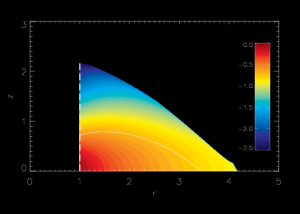Active Galactic Nuclei

Active galactic nuclei (AGNs) are compact and extreme luminous regions in the center of galaxies which are powered by mass accretion on to super-massive (more than one million solar mass) black holes. A torus-like dust+gas mixture surrounds and obscures the central engine and gives rise to all sorts of AGNs we observed by simply varying the view angles. But how does the obscuring torus sustain its large geometrically thickness against gravity puzzles the scientists for decades. We have propose that the radiation pressure from the reprocessed infrared emission by dust is strong enough to sustain the thick structure of the torus. We constructed an equilibrium model which includes both the radiation pressure support from dust, and also localized energy sources such as starlight irradiation, and hard X-rays caused Compton heating which are generally expected in these systems. The model proves that infrared radiation pressure can support its structure, as shown in the distribution plots of matter density (top) and energy density (bottom). The predicted AGN luminosities also agree well with the observations. This work therefore resolves, at least partially, the problem of how to model an AGN torus. It introduces the fundamental physics and inspires further studies, such as dynamical models carried out by others later on. (paper link at ADS & astro-ph)
irradiation, and hard X-rays caused Compton heating which are generally expected in these systems. The model proves that infrared radiation pressure can support its structure, as shown in the distribution plots of matter density (top) and energy density (bottom). The predicted AGN luminosities also agree well with the observations. This work therefore resolves, at least partially, the problem of how to model an AGN torus. It introduces the fundamental physics and inspires further studies, such as dynamical models carried out by others later on. (paper link at ADS & astro-ph)